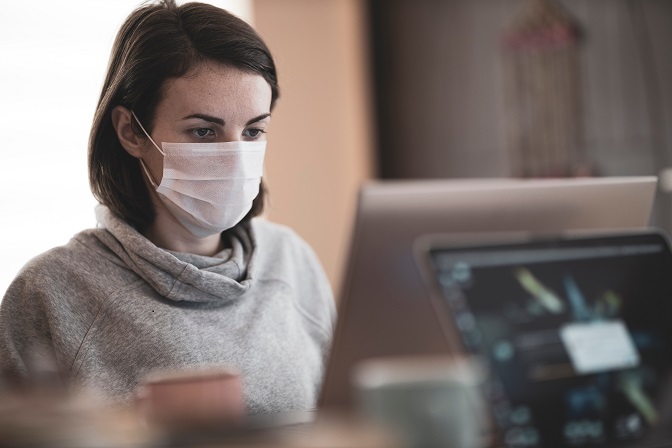There are overwhelming evidences to confirm that the dominant route of transmission of severe acute respiratory syndrome coronavirus-2 (SARS-CoV-2) is airborne. This realisation has significant implications for fine-tuning of strategies to manage the pandemic, particularly in terms of importance attached to wearing of masks and avoiding gatherings of people till the population achieves herd immunity through immunisation. In view of this, the recent easing of restrictions in the UK allowing re-opening of public buildings, outdoor hospitality, attractions and events and indoor leisure and sports facilities may need to be re-thought and re-considered.
The dominant mode of transmission of the SARS-CoV2 virus is undoubtedly airborne1-3 which means that it can be contracted by breathing contaminated air. It has also been hypothesized that the virus can remain in the air for about 3 hours with a half-life of 1.1 hours4, suggesting that even when an infected person leaves a place, there are chances of another non-infected person contracting the disease when he/she comes in contact with the air that has been contaminated without the presence of other person being in proximity. This puts COVID-19 disease in the category of other air borne diseases such as whooping cough, tuberculosis, common cold, influenza and measles.
Since the virus responsible for causing COVID-19 is airborne, there is a need to re-emphasize wearing of masks not only in public places, but also indoors where there is a suspicion of air being contaminated with the virus. In addition, there is limited evidence to support other routes of transmission such as respiratory droplet or surfaces contaminated with the virus that can cause infection 5-6. Maintaining social distancing and avoiding large scale gatherings that can lead to higher transmission/infection should remain in place. This translates to wearing masks all the time while being in public places or better yet by continuing closure of public places till an acceptable level of herd immunity has been developed by means of large-scale vaccination. This also means that the air ventilation systems in hospitals need to be re assessed to ensure that the health workers are at a minimum risk due to exposure to contaminated indoor air. Physical isolation of positive cases with separate air flow containment may be the need of the hour to ensure proper treatment of the patients along with protection of healthcare workers by wearing modified PPE’s with self-contained breathing apparatus. In addition, continuous testing of individuals would be required to assess when the person becomes non-infective and is unable to transmit the disease by releasing virus in the exhaled air by means of coughing/sneezing etc. Till the time the individual is positive, he/she has to remain in self-quarantine at home to ensure that the transmission to other persons is minimised.
In the wake of the reconfirmation of COVID-19 to be predominantly airborne, the current ease of restrictions since 12th April in the UK allowing reopening of non-essential retail outlets, personal care services such as hairdressers and nail salons, public buildings such as libraries and community centres, outdoor hospitality venues and tourist attractions, outdoor events and indoor leisure and sports facilities may require reconsideration7.
***
References
- Greenhalgh T, Jimenez JL, et al 2021. Ten scientific reasons in support of airborne transmission of SARS-CoV-2. Lancet. Published 15 April 2021. DOI: https://doi.org/10.1016/S0140-6736(21)00869-2
- Heneghan C, Spencer E, Brassey J et al. 2021. SARS-CoV-2 and the role of airborne transmission: a systematic review. F1000Research. 2021. Published online 24 March 2021. (preprint). DOI: https://doi.org/10.12688/f1000research.52091.1
- Eichler N, Thornley C, Swadi T et al 2021. Transmission of severe acute respiratory syndrome coronavirus 2 during border quarantine and air travel, New Zealand (Aotearoa). Emerging Infect Dis. 2021; (published online March 18.) DOI: https://doi.org/10.3201/eid2705.210514
- Van Doremalen N, Bushmaker T, Morris DH et al. Aerosol and surface stability of SARS-CoV-2 as compared with SARS-CoV-1. New Engl J Med. 2020; 382: 1564-1567.DOI: https://doi.org/10.1056/NEJMc2004973
- Chen W, Zhang N, Wei J, Yen H-L, Li Y Short-range airborne route dominates exposure of respiratory infection during close contact. Building Environ. 2020; 176106859. DOI: https://doi.org/10.1016/j.buildenv.2020.106859
- Goldman E. Exaggerated risk of transmission of COVID-19 by fomites. Lancet Infect Dis 2020; 20: 892–93. DOI: https://doi.org/10.1016/S1473-3099(20)30561-2
- UK Govt. 2021. Coronavirus (COVID-19). Guidance – Coronavirus restrictions: what you can and cannot do. Available online at https://www.gov.uk/guidance/covid-19-coronavirus-restrictions-what-you-can-and-cannot-do#april-whats-changed. Accessed on 16 April 2021.
***




































